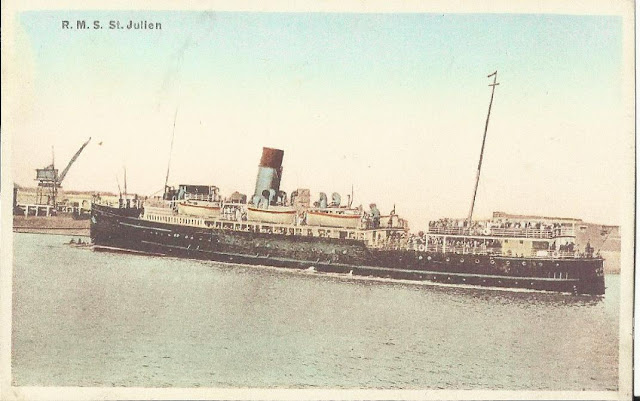The SS St Julien was one of a pair of steam ships built by John Brown of Clydebank for the Great Western Railway's Weymouth to Channel Islands services. She was launched on the Clyde in Feb 1925. Her sister ship was the St Helier. My Grandfather, Charlie Pavey, was the Quartermaster on this ship during the late 1920s and throughout the 1930s. He was born and bred in Weymouth but he must have met my "grandmother to be" on one of his trips to Jersey and after they were married he moved to St Helier and continued to work on the ships from his Jersey base.
 |
| GWRSS St Julien just after launch with dummy funnel still in place. |
St Julien was originally delivered with two funnels, but the second was in fact a dummy which was removed in 1928. When war broke out in 1939 the service between Weymouth and the Channel Islands was suspended. St Julien entered Weymouth on at 8pm on September 9th carrying the last holidaymakers from Jersey. 3 days later she left for Avonmouth where she was initially put to use ferrying troops. However. after only two trips to St Nazaire, she was very quickly converted into a Hospital Carrier operating out of Newhaven and Southampton. She took part in the evacuation of British troops from Dunkirk, Boulogne and Cherbourg in 1940. On May 29th 1940, during the Dunkirk operation, St Julien was deliberately bombed by the Luftwaffe for a considerable period of time. Although she never received a direct hit, she was damaged by shrapnel from numerous near misses. It was during this raid that my grandfather was hit in the chest by flying debris and suffered the effects of shell-shock. St Julien remained just off Dunkirk for half an hour waiting for an opportunity to land, but when the air attacks started again she sailed back to Dover to offload her injured crew before returning to Dunkirk next morning where she successfully rescued 287 casualties.
 |
| SS St Julien with dummy funnel removed. |
As I had mentioned earlier, my family were living in Jersey at the start of World War II. Grandad Charlie was sent home to Jersey to recover from his injuries that he had received at Dunkirk, but less than two weeks later the German army began their invasion of the Channel Islands. He quickly arranged for the family to evacuate the Island before the German forces landed, but he couldn't find his youngest son David (my father). Eventually he was found on the beach watching all the activity. My Uncle Dennis grabbed him and dragged him back home. They made their way to the harbour in St Helier with only the clothes he was wearing and a bag that my Gran had packed for him. They boarded a ship that took them to Southampton and from there the family made their way back the family home in Weymouth.
Grandad Charlie contracted TB whilst he was convalescing and eventually lost one of his lungs. He was unable to return to work the ship, but the St Julien spent the remainder of World War II as a hospital carrier and saw service in the Mediterranean as well as the D-Day Landings in 1944 where she pressed into service for the US Navy. She was damaged by a mine on June 7th and had to be towed back to England with her bows well down in the water. Less than three weeks later she was back in service in Normandy assisting with American casualties at Arrowmanches.
 |
| HM Hospital Carrier St Julien clearing casualties from Arrowmanches in July 1944 |
 |
| SS St Julien in St Helier Harbour, Jersey 1955. This photo was taken by my mother when she went to Jersey to see my Dad's family shortly before their wedding . |
In 1946 St Julien was returned to the GWR at Weymouth and was passed on to British Railways on 1st January 1948 when GWR became part of the British Transport Commission (British Railways). Another member of my Weymouth family worked on the ship during her final years. Alfred John Lanning Pavey was recorded as 1st Engineer on St Julien in 1948. He was the son of Grandfather's brother. St Julien made her last Channel Islands crossing on 27th September 1960 when the two sister ships were replaced by the new SS Caesarea and SS Sarnia. She was scrapped the following year and sold to Van Heyghen Freres, Ghent in March 1961. She was last heard of being used by Dockyard workers at Walcheren in late 1963.
 |
| St Julien with windows plated up on the sides of the main deck and a white forecastle. |
Specifications:
Propulsion: 4 Parsons steam turbines SRG two shafts 18kn 4350bhp
Ship Type: Passenger Vessel
Ship's Role: Channel Island ferry
Tonnage: 1885gross tons.
Length: 282.2 feet
Breadth: 40 feet
Draught: 13 feet
Owner History:
Great Western Railway Co, London; 1925-1939 and 1946-1948
British Railways Southern Region; 1948-1961

A very enjoyable read.Thankyou.
ReplyDeletePeter Barron.
As a young apprentice Shipwright in 1960,I can remember going aboard doing lots of small jobs on both the St Julien and her sister ship the St Helier.My father worked on Weymouth Quay as a ships fueller,so we had free passage on the ships to the Channel Islands lots of times when I was young.In the rough weather which never seemed to stop them sailing I can also remember on night crossings the ship creaking as it went through the rough seas,especially between Guernsey and Jersey.I spent 26 good years working on all of the boats that sailed out of the port of Weymouth..My Grandfather also worked on all of the old boats,including the IBEX / REINDEER etc right up until he retired,he worked in the engine room as a stoker. Regards Peter Barron
ReplyDelete